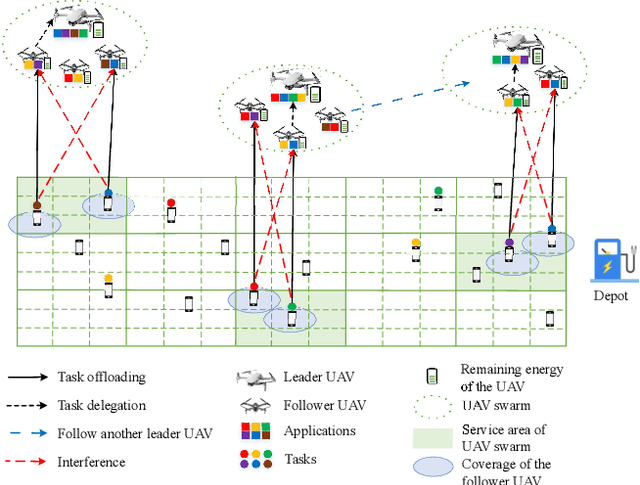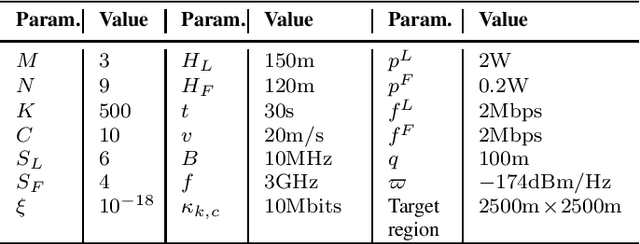Changyan Yi
Sherman
Towards Intelligent Transportation with Pedestrians and Vehicles In-the-Loop: A Surveillance Video-Assisted Federated Digital Twin Framework
Mar 06, 2025Abstract:In intelligent transportation systems (ITSs), incorporating pedestrians and vehicles in-the-loop is crucial for developing realistic and safe traffic management solutions. However, there is falls short of simulating complex real-world ITS scenarios, primarily due to the lack of a digital twin implementation framework for characterizing interactions between pedestrians and vehicles at different locations in different traffic environments. In this article, we propose a surveillance video assisted federated digital twin (SV-FDT) framework to empower ITSs with pedestrians and vehicles in-the-loop. Specifically, SVFDT builds comprehensive pedestrian-vehicle interaction models by leveraging multi-source traffic surveillance videos. Its architecture consists of three layers: (i) the end layer, which collects traffic surveillance videos from multiple sources; (ii) the edge layer, responsible for semantic segmentation-based visual understanding, twin agent-based interaction modeling, and local digital twin system (LDTS) creation in local regions; and (iii) the cloud layer, which integrates LDTSs across different regions to construct a global DT model in realtime. We analyze key design requirements and challenges and present core guidelines for SVFDT's system implementation. A testbed evaluation demonstrates its effectiveness in optimizing traffic management. Comparisons with traditional terminal-server frameworks highlight SV-FDT's advantages in mirroring delays, recognition accuracy, and subjective evaluation. Finally, we identify some open challenges and discuss future research directions.
Exploiting NOMA Transmissions in Multi-UAV-assisted Wireless Networks: From Aerial-RIS to Mode-switching UAVs
Dec 29, 2024Abstract:In this paper, we consider an aerial reconfigurable intelligent surface (ARIS)-assisted wireless network, where multiple unmanned aerial vehicles (UAVs) collect data from ground users (GUs) by using the non-orthogonal multiple access (NOMA) method. The ARIS provides enhanced channel controllability to improve the NOMA transmissions and reduce the co-channel interference among UAVs. We also propose a novel dual-mode switching scheme, where each UAV equipped with both an ARIS and a radio frequency (RF) transceiver can adaptively perform passive reflection or active transmission. We aim to maximize the overall network throughput by jointly optimizing the UAVs' trajectory planning and operating modes, the ARIS's passive beamforming, and the GUs' transmission control strategies. We propose an optimization-driven hierarchical deep reinforcement learning (O-HDRL) method to decompose it into a series of subproblems. Specifically, the multi-agent deep deterministic policy gradient (MADDPG) adjusts the UAVs' trajectory planning and mode switching strategies, while the passive beamforming and transmission control strategies are tackled by the optimization methods. Numerical results reveal that the O-HDRL efficiently improves the learning stability and reward performance compared to the benchmark methods. Meanwhile, the dual-mode switching scheme is verified to achieve a higher throughput performance compared to the fixed ARIS scheme.
Energy-Efficient UAV Swarm Assisted MEC with Dynamic Clustering and Scheduling
Feb 29, 2024


Abstract:In this paper, the energy-efficient unmanned aerial vehicle (UAV) swarm assisted mobile edge computing (MEC) with dynamic clustering and scheduling is studied. In the considered system model, UAVs are divided into multiple swarms, with each swarm consisting of a leader UAV and several follower UAVs to provide computing services to end-users. Unlike existing work, we allow UAVs to dynamically cluster into different swarms, i.e., each follower UAV can change its leader based on the time-varying spatial positions, updated application placement, etc. in a dynamic manner. Meanwhile, UAVs are required to dynamically schedule their energy replenishment, application placement, trajectory planning and task delegation. With the aim of maximizing the long-term energy efficiency of the UAV swarm assisted MEC system, a joint optimization problem of dynamic clustering and scheduling is formulated. Taking into account the underlying cooperation and competition among intelligent UAVs, we further reformulate this optimization problem as a combination of a series of strongly coupled multi-agent stochastic games, and then propose a novel reinforcement learning-based UAV swarm dynamic coordination (RLDC) algorithm for obtaining the equilibrium. Simulations are conducted to evaluate the performance of the RLDC algorithm and demonstrate its superiority over counterparts.
Edge Computing Enabled Real-Time Video Analysis via Adaptive Spatial-Temporal Semantic Filtering
Feb 29, 2024



Abstract:This paper proposes a novel edge computing enabled real-time video analysis system for intelligent visual devices. The proposed system consists of a tracking-assisted object detection module (TAODM) and a region of interesting module (ROIM). TAODM adaptively determines the offloading decision to process each video frame locally with a tracking algorithm or to offload it to the edge server inferred by an object detection model. ROIM determines each offloading frame's resolution and detection model configuration to ensure that the analysis results can return in time. TAODM and ROIM interact jointly to filter the repetitive spatial-temporal semantic information to maximize the processing rate while ensuring high video analysis accuracy. Unlike most existing works, this paper investigates the real-time video analysis systems where the intelligent visual device connects to the edge server through a wireless network with fluctuating network conditions. We decompose the real-time video analysis problem into the offloading decision and configurations selection sub-problems. To solve these two sub-problems, we introduce a double deep Q network (DDQN) based offloading approach and a contextual multi-armed bandit (CMAB) based adaptive configurations selection approach, respectively. A DDQN-CMAB reinforcement learning (DCRL) training framework is further developed to integrate these two approaches to improve the overall video analyzing performance. Extensive simulations are conducted to evaluate the performance of the proposed solution, and demonstrate its superiority over counterparts.
Generative AI-Driven Human Digital Twin in IoT-Healthcare: A Comprehensive Survey
Jan 22, 2024Abstract:The Internet of things (IoT) can significantly enhance the quality of human life, specifically in healthcare, attracting extensive attentions to IoT-healthcare services. Meanwhile, the human digital twin (HDT) is proposed as an innovative paradigm that can comprehensively characterize the replication of the individual human body in the digital world and reflect its physical status in real time. Naturally, HDT is envisioned to empower IoT-healthcare beyond the application of healthcare monitoring by acting as a versatile and vivid human digital testbed, simulating the outcomes and guiding the practical treatments. However, successfully establishing HDT requires high-fidelity virtual modeling and strong information interactions but possibly with scarce, biased and noisy data. Fortunately, a recent popular technology called generative artificial intelligence (GAI) may be a promising solution because it can leverage advanced AI algorithms to automatically create, manipulate, and modify valuable while diverse data. This survey particularly focuses on the implementation of GAI-driven HDT in IoT-healthcare. We start by introducing the background of IoT-healthcare and the potential of GAI-driven HDT. Then, we delve into the fundamental techniques and present the overall framework of GAI-driven HDT. After that, we explore the realization of GAI-driven HDT in detail, including GAI-enabled data acquisition, communication, data management, digital modeling, and data analysis. Besides, we discuss typical IoT-healthcare applications that can be revolutionized by GAI-driven HDT, namely personalized health monitoring and diagnosis, personalized prescription, and personalized rehabilitation. Finally, we conclude this survey by highlighting some future research directions.
Resource-efficient Generative Mobile Edge Networks in 6G Era: Fundamentals, Framework and Case Study
Dec 19, 2023Abstract:As the next-generation wireless communication system, Sixth-Generation (6G) technologies are emerging, enabling various mobile edge networks that can revolutionize wireless communication and connectivity. By integrating Generative Artificial Intelligence (GAI) with mobile edge networks, generative mobile edge networks possess immense potential to enhance the intelligence and efficiency of wireless communication networks. In this article, we propose the concept of generative mobile edge networks and overview widely adopted GAI technologies and their applications in mobile edge networks. We then discuss the potential challenges faced by generative mobile edge networks in resource-constrained scenarios. To address these challenges, we develop a universal resource-efficient generative incentive mechanism framework, in which we design resource-efficient methods for network overhead reduction, formulate appropriate incentive mechanisms for the resource allocation problem, and utilize Generative Diffusion Models (GDMs) to find the optimal incentive mechanism solutions. Furthermore, we conduct a case study on resource-constrained mobile edge networks, employing model partition for efficient AI task offloading and proposing a GDM-based Stackelberg model to motivate edge devices to contribute computing resources for mobile edge intelligence. Finally, we propose several open directions that could contribute to the future popularity of generative mobile edge networks.
A Revolution of Personalized Healthcare: Enabling Human Digital Twin with Mobile AIGC
Jul 22, 2023Abstract:Mobile Artificial Intelligence-Generated Content (AIGC) technology refers to the adoption of AI algorithms deployed at mobile edge networks to automate the information creation process while fulfilling the requirements of end users. Mobile AIGC has recently attracted phenomenal attentions and can be a key enabling technology for an emerging application, called human digital twin (HDT). HDT empowered by the mobile AIGC is expected to revolutionize the personalized healthcare by generating rare disease data, modeling high-fidelity digital twin, building versatile testbeds, and providing 24/7 customized medical services. To promote the development of this new breed of paradigm, in this article, we propose a system architecture of mobile AIGC-driven HDT and highlight the corresponding design requirements and challenges. Moreover, we illustrate two use cases, i.e., mobile AIGC-driven HDT in customized surgery planning and personalized medication. In addition, we conduct an experimental study to prove the effectiveness of the proposed mobile AIGC-driven HDT solution, which shows a particular application in a virtual physical therapy teaching platform. Finally, we conclude this article by briefly discussing several open issues and future directions.
 Add to Chrome
Add to Chrome Add to Firefox
Add to Firefox Add to Edge
Add to Edge